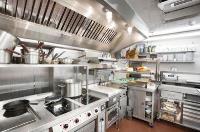 Add My Company
Add My Company
Sign In

The design and layout of a commercial kitchen can mean the difference between a successful restaurant and one that doesn't achieve the desired success. A poorly designed kitchen will lead to disorganisation and delays in service. You'll get through fewer covers during service which will ultimately affect the profit margin of your restaurant business. A kitchen should be designed to make service flow smoothly and quickly, enabling your chefs to keep up with the demands of the covers. When planning the design and layout for a commercial kitchen you need to consider the following factors:
commercial kitchen layout
commercial kitchen layout
Available space - The general rules for the kitchen space is to allow five square feet of space per seat in your restaurant. Therefore if your restaurant can hold 100 customers at full capacity then you'd ideally need a 500 square foot kitchen. Once you have allocated the right amount of space to you kitchen it's then important to make sure that space gets used as efficiently as possible. Mobility -A commercial kitchen that has been arranged well should allow employees to move around easily without bumping into one another or bumping into equipment or fixtures. The easy mobility of your employees is essential for a smooth-running kitchen, especially during peak service times. Health and safety - Whether you're setting up a brand new commercial kitchen or refurbishing an existing one it's important to keep your local health and safety executive informed. They're always on hand to provide any advice and guidance that you need whilst you're setting your kitchen up and once the restaurant is open. Ergonomics - The fewer steps your employees need to take in completing a task, the better it is all round. An ergonomically designed kitchen should enable employees to complete all of their tasks in one spot with minimal bending, reaching, turning and walking. Ergonomics in the kitchen can also help to reduce the amount of injury, discomfort and fatigue experienced by employees. Energy efficiency - Commercial kitchens that have energy efficiency as one of their primary considerations will ultimately save money on their utility costs, thus improving their profit margin. Refrigeration and cooking equipment should be kept as far apart as is practicable while cooking equipment should be arranged in order to maximise the efficiency of the extractor hood. Flexibility - It is important for a commercial kitchen to be flexible in its layout. Changes in food trends could lead to new menus, which in turn can lead to certain equipment now being used more or less often that it previously was, so the location of the equipment may need to be revised. It is recommended that equipment is placed so that it is easy to move during cleaning anyway. Sensory appeal - Your customers will be able to smell the appetising food being prepared in the kitchen, but you could use the kitchen layout to appeal to their other senses too. Exhibit kitchens allow your customers to see what is going on, so this appeals to their visual sense.
For more information on Commercial Kitchen Layout talk to Target Catering Equipment
Enquire Now
More related to Commercial Kitchen Layout
List your company on FindTheNeedle.
